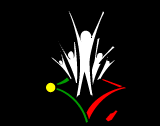World Festival of Black Arts
| World Festival of Black Arts | |
|---|---|
 World Festival of Black Arts (FESMAN) | |
| Genre | Pan-African |
| Dates | December |
| Location(s) | Dakar, Senegal; Lagos, Nigeria |
| Years active | 1966, 1977, 2009/2010 |
| Founded by | Leopold Senghor |
| Website | http://blackworldfestival.com |
The World Festival of Black Arts (French: Festival Mondial des Arts Nègres), also known as FESMAN, is a month-long culture and arts festival that takes place in Africa. The festival features poetry, sculpture, painting, music, cinema, theatre, fashion, architecture, design and dance from artists and performers from around the African Diaspora.[1]
History
The festivals were planned as Pan-African celebrations, and ranged in content from debate to performance — particularly dance and theatre.[2]
Dakar, 1966
The First World Festival of Black Arts or World Festival of Negro Arts was held in Dakar, Senegal, 1–24 April 1966, initiated by former President Leopold Senghor, under the auspices of UNESCO,[3] with the participation of 45 African, European, Caribbean, and North and South African countries, and featuring black literature, music, theater, visual arts, film and dance.[4] It was first state-sponsored festival to showcase the work of African and African diasporic artists, musicians and writers to a global audience.[5] Participants included historian Cheikh Anta Diop; dancers Arthur Mitchell and Alvin Ailey; Mestre Pastinha, a Capoeira troupe from Bahia; Duke Ellington; Marion Williams; singers Julie Akofa Akoussah and Bella Bellow; writers Aimé Césaire, Langston Hughes, Wole Soyinka, Amiri Baraka, Sarah Webster Fabio, and Nelson Mandela.[6] The filmmaker William Greaves made a 40-minute documentary of the event entitled The First World Festival of Negro Arts (1968).[7] Italian journalist Sergio Borelli produced Il Festival de Dakar (1966)[8][9] a 50-minute documentary for RAI.
Lagos, 1977
In 1977, from 15 January to 12 February, the Second World Festival of Black Arts or Black and African Festival of Arts and Culture — known as FESTAC '77 — took place in Lagos, Nigeria, under the patronage of President Olusegun Obasanjo.[10] Attended by more than 17,000 participants from over 50 countries, it was the largest cultural event ever held on the African continent.[10] Among artists who took part were Stevie Wonder, the Sun Ra Arkestra, and Donald Byrd from the US, Tabu Ley and Franco from the Congo, Gilberto Gil from Brazil, Bembeya Jazz National from Guinea, and Louis Moholo, Dudu Pukwana, and Miriam Makeba from South Africa.[11]
Dakar, 2010
The 2010 World Festival of Black Arts took place 10–31 December 2010, and was initiated by Senegalese President Abdoulaye Wade with the theme of African Renaissance. In President Wade's 2009 address at the UN, he said: "I call all Africans, all the sons and daughters of the Diaspora, all my fellow citizens, all the partners that are ready to walk by our side, all States, all international organizations, foundations, firms, etc. for a shining success for this Festival, and for the rise of a new Africa." It was curated by Kwame Kwei-Armah, and participants at the opening ceremony included Youssou N'Dour, Baaba Maal, Angélique Kidjo, Toumani Diabaté, Wyclef Jean, Carlinhos Brown and the Mahotella Queens.[12][13] As well as music and cinema, the festival featured art exhibitions, theatre and dance performances, fashion shows, photography and other events, with the participation of artists and intellectuals from dozens of African and African diaspora countries, including the US, Brazil, Haiti, France and Cuba.[14][13]
References
- ↑ "World Festival of Black Arts launched at UN Headquarters", People's Daily, 15 January 2009.
- ↑ Martin Banham, Errol Hill, George Woodyard (eds), The Cambridge Guide to African & Caribbean Literature, Cambridge University Press, 1994; "FESTAC", p. 3.
- ↑ "1st World Festival of Negro Arts, Dakar, April 1-24, 1966: Colloquium: Function and Significance of African Negro Art in the Life of the People and for the People, March 30-April 8, 1966; 1968". unesdoc.unesco.org. Retrieved 8 March 2018.
- ↑ "First World Festival of Negro Arts. U.S. Committee Records", New York Public Library.
- ↑ "World Festival of Negro Arts", Tate.
- ↑ "Dakar 1966 – 1er Festival Mondial des Arts Nègres", Continuo, 25 November 2009.
- ↑ "The First World Festival of Negro Arts", African Film Festival, New York.
- ↑ borelli, caterina (10 August 2015). ""Festival mondial des arts nègres"- "World Festival of Black Arts" by Sergio Borelli, 50 min". Retrieved 8 March 2018 – via Vimeo.
- ↑ "African Presences I: Music in Africa » Pan-African Festivals". musc265.blogs.wesleyan.edu. Retrieved 8 March 2018.
- 1 2 "FESTAC '77 - 2nd World Black & African Festival of Arts - NaijaPositive.com". naijapositive.myfastforum.org. Retrieved 8 March 2018.
- ↑ "The History of the World Festival of Black Arts & Culture / FESTAC", Afropop Worldwide, 20 January 2011.
- ↑ Hannah Pool, "World Festival of Black Arts: a once in a decade event", The Guardian, 3 January 2011.
- 1 2 Felicia R. Lee, "World Festival of Black Arts Announces Lineup", ArtsBeat, The New York Times, 7 December 2010.
- ↑ Karima Daoudi, "The World Festival of Black Arts and Cultures", Fulbright-mtvU Fellows, 21 March 2011.
Further reading
- Murphy, David (2017). "Dakar 66: Chronicles of a Pan-African Festival – Musée du Quai Branly, Paris February 16–May 15, 2016". African Arts. 50 (1): 80–82. doi:10.1162/AFAR_r_00333. ISSN 0001-9933 – via MIT Press Journals.
External links
- Facebook site for the 2009 festival
- US FESMAN Committee
- "Black World Festival", Funnelme.
- "Festac 77 - Lagos Festival", UNESCO.
- “Festival mondial des arts nègres”- “World Festival of Black Arts” by Sergio Borelli, 50 min. Report made for television of the Dakar Arts Festival of 1966. Featuring Senghor, Duke Ellington and Langston Hughes.